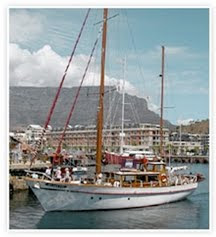
The Howard Davis trains again
Commencing on the 7th of May 2010, Cape Windjammers Education Trust will be running their one-day marine environment awareness voyages aboard the Howard Davis which is a classic sail training yacht originally commissioned for the South African Merchant Navy in 1965. After spending over 25 years in service at the General Botha Sailing Academy the Howard Davis is now in private ownership under command of its skipper Charles Fenton. Once again she will be involved in training young South Africans giving these youths the opportunity to receive character building and nautical training of the highest standard. The Howard Davis follows in the proud tradition of sv Lawhill and SATS General Botha and will be followed by a new sail training "tall ship" currently in the planning stage.
The Howard Davis was named after the son of Thomas Benjamin Frederick DAVIS. Saddened by the death of his son Howard during World War I, T.B. Davis, who is featured on this picture at the helm of his yacht "Westward" conceived and executed on his own initiative a living memorial to his late son in the form of the first Training Ship in the Southern hemisphere, named after South Africa's first Prime Minister, General Botha. T.B. Davis stipulated that the ship be used for the full time training of boys of British South Africa thus giving these youths the opportunity to receive character building and nautical training of the highest standard, to serve in ships sailing under flags of Great Britain and the British Empire
TB Davis was a keen yachtsman in the grand style, making his own sails for his yacht the 'Westward' which was a familiar entry for Cowes Week for many years.
Captain Phil Nankin, a General Botha old boy, sailed the Cape Horn "tall ships" the sv Passat and sv Cariad and of course on South Africa's own (prize of war) Cape Horner the sv Lawhill as deckboy, cadet, third officer, second officer and later chief officer. In 1963 Phil Nankin was appointed Captain Superintendent of the South African Merchant Navy Academy General Botha - and remained in office until March 1985.
The sail-training vessel Howard Davis was the brainchild of Phil Nankin who knew from experience the great value of training under sail. In later years he was a keen supporter and life member of Cape Windjammers and a strong advocate of their campaign to acquire a sail training ship for South Africa. Phil understood well that the main value of sail training in this modern machine age lay in its unique ability to foster the somewhat old-fashioned character virtues of courage, comradeship and endurance. The objective was not merely to expose young officers and sailors to the use of sails, various types of ropes and operation of ships of the bygone era. The aim was primarily to develop a spirit of adventure and inculcate in each man the laudable qualities of team work, cohesiveness, esprit de corps, alertness, physical and mental agility, leadership qualities and the ability to face challenges with confidence, resoluteness and a positive attitude.
The Howard Davis was designed by Kurt Oehlman and built by Louw and Halvorson. She was designed with a large saloon with all round visibility to make it suitable for teaching a class of upcoming navigators.
Launched in 1965 at Quay 4 in the Victoria Basin. She spent the next 25 years based at Granger Bay in service with the Academy, during which time she was used for sail training and navigational exercises.
In 1971 she was used as guard ship for the first Cape to Rio yacht race under the command of Captain Phil Nankin; and subsequently completed several Atlantic Ocean crossings to South America.
In 1991 due to restructuring in the budget as well as the training syllabus of the Academy, she was sold into the private sector. The current owner has done extensive renovations and she is once again safe and suitable to train young people.
Technical Specifications
Construction: Mahogany on Oroko frames
Length overall: 66 ft
Length waterline: 58 ft
Gross tonnage: 53.65
Ballast: 16 ton lead keel
Original compliment: 2 Officers and 12 Ratings
Main Engine: 215 hp Perkins Turbo diesel
Fuel Capacity: 3800L
Sail area: +/- 200sqm
Please support sail-training on the Howard Davis.
Mail just in from Chris Sutton in Durban reads:
I was at the Bothy in 1983 and did quite a few miles on The Hotdog and the HD was fondly known.
Cheers,
Chris

































